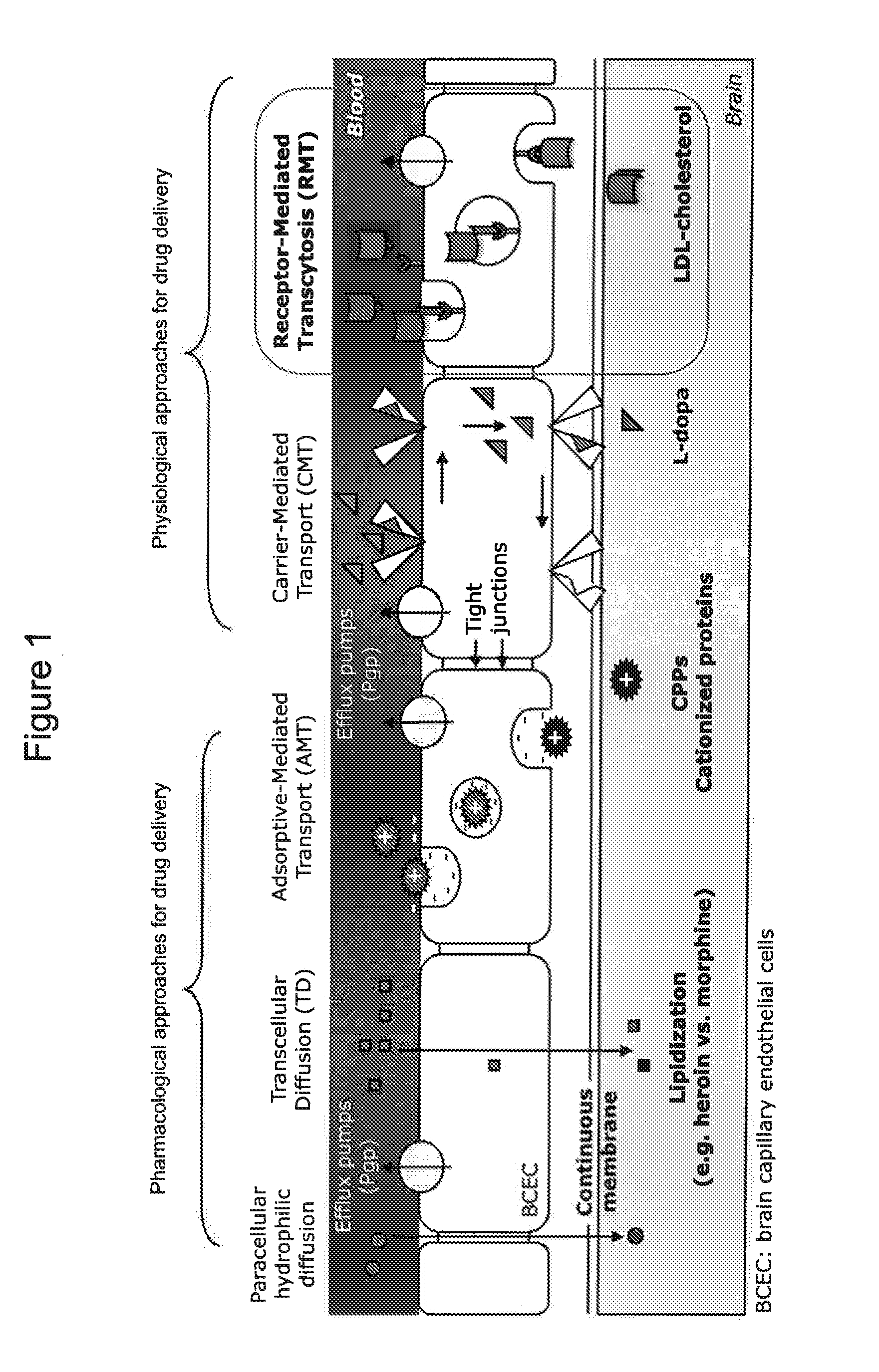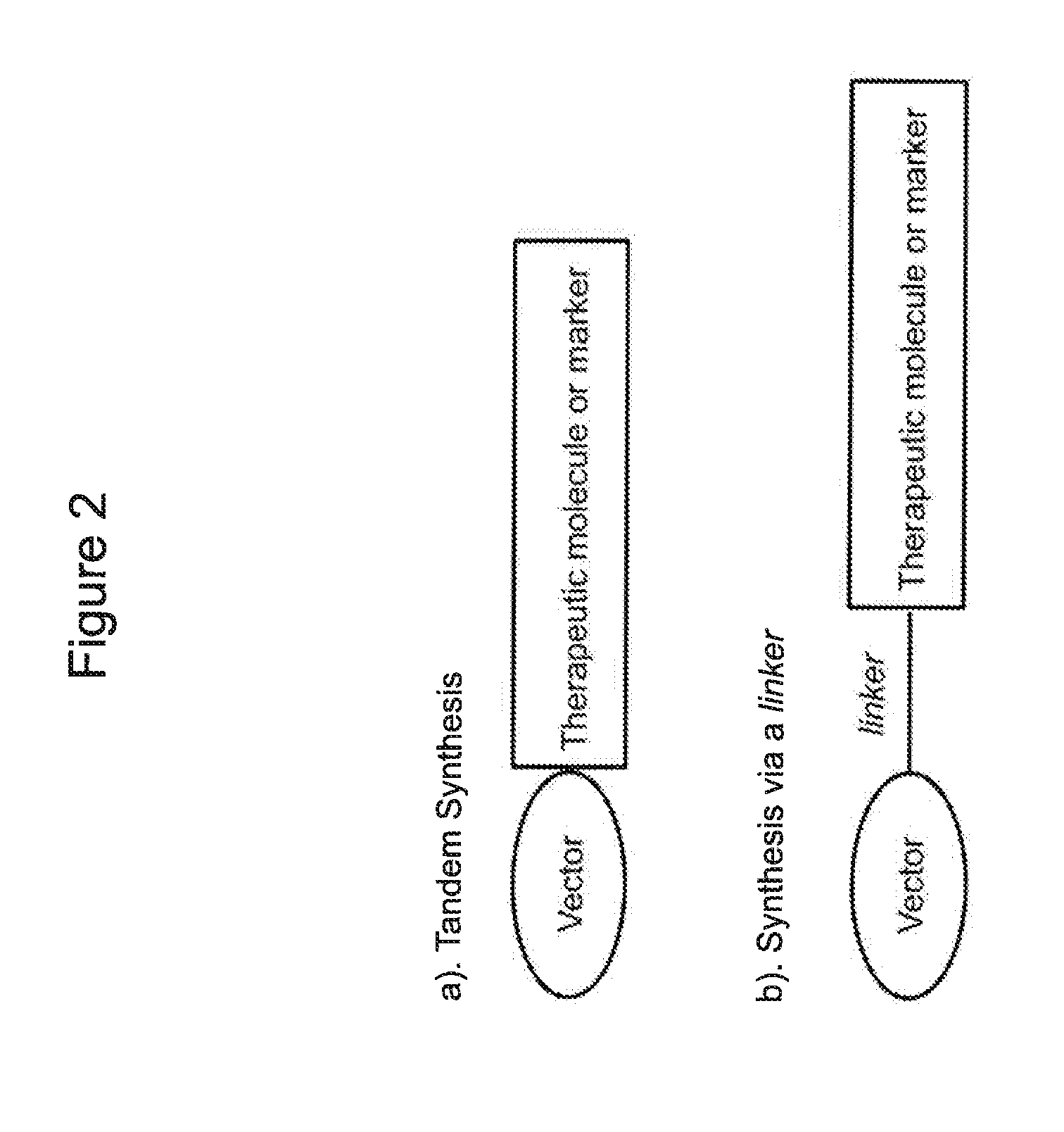Peptide derivatives, preparation and uses thereof
- Summary
- Abstract
- Description
- Claims
- Application Information
AI Technical Summary
Benefits of technology
Problems solved by technology
Method used
Image
Examples
example i
[0133]Construction of Cho cell lines stably expressing human mouse and rat LDLR.
[0134]The inventors identified peptides on the basis of their interaction with and affinity for human mouse and rat low-density lipoproteins receptors (hLDLR, mLDLR and rLDLR respectively), which are notably involved in the endocytosis and transcytosis (transcellular transport) of cholesterol. The prerequisite to the characterization of these peptides was the establishment in eukaryotic cells (Chinese hamster ovary cells, CHO) of stable cell lines expressing hLDLR, mLDLR and rLDLR constitutively and at high rates. These cell lines are used: i) for the characterization of peptides binding to hLDLR expressed at the cell surface, in its native configuration; ii) to verify that hLDLR, mLDLR and rLDLR can internalize the selected peptides by endocytosis.
[0135]The construction of these cell lines (except the cell line expressing rLDLR) has been described in application WO2010 / 046588. Briefly, the messenger RNA...
example ii
[0142]Synthesis of peptides and coupling with a tracer molecule (biotin, fluoresceins, rhodamines, cyanines or STag with enzymatic activity).
[0143]Peptides were synthesized by the solid phase peptide synthesis (SPPS) method on an Advanced ChemTech Apex396 (AAPPTec) synthesizer, or a Liberty™ (CEM) microwave synthesizer, using an Fmoc / tBu strategy on Rink Amide AM resin on polystyrene-1% DVB, Wang on polystyrene-1% DVB, Barlos (2-chlorotrityl chloride) on polystyrene-1% DVB, or Sieber Amide on polystyrene-1% DVB. The load (or substitution) is between 0.25 mmol / g and 1.6 mmol / g according to the resin used.
[0144]The amino acids N-protected by Fmoc (or Boc for certain N-term ends) and / or protected by orthogonal functions (notably acid labile functions) at their side chains, the chemical coupling and deprotection reagents and the solvents are bought from specialized companies and are used as-is.
[0145]The Rink Amide and Wang resins make it possible to synthesize peptide sequences complete...
example iii
Peptide Vectors Design
[0162]The peptide of sequence SEQ ID NO: 17 / STag, described in application WO2010 / 046588, was used as the reference.
[0163]From this peptide, various approaches were used to try to improve binding, synthesis and vectorization properties. Many peptides were thus synthesized, differing from SEQ ID NO: 17 by the deletion and / or the replacement and / or the chemical modification of one or more amino acid residues.
[0164]The capacity of the peptides thus synthesized to bind hLDLR was determined.
[0165]To this end, adherent and confluent CHO-hLDLR-RFP cells were cultivated in 6-well plates. Three wells of cells are used per condition.
[0166]A solution containing 10 μM of peptide SEQ ID NO: 17 / STag was prepared in HamF12-1% BSA culture medium. To this solution was added 10 μM of the peptide to evaluate (competition).
[0167]Several control solutions are also prepared:[0168](i) HamF12-1% BSA medium.[0169](ii) HamF12-1% BSA medium+10 μM control peptide CTRL-STag (evaluation of ...
PUM
| Property | Measurement | Unit |
|---|---|---|
| Composition | aaaaa | aaaaa |
| Density | aaaaa | aaaaa |
| Hydrophobicity | aaaaa | aaaaa |
Abstract
Description
Claims
Application Information
 Login to view more
Login to view more - R&D Engineer
- R&D Manager
- IP Professional
- Industry Leading Data Capabilities
- Powerful AI technology
- Patent DNA Extraction
Browse by: Latest US Patents, China's latest patents, Technical Efficacy Thesaurus, Application Domain, Technology Topic.
© 2024 PatSnap. All rights reserved.Legal|Privacy policy|Modern Slavery Act Transparency Statement|Sitemap



